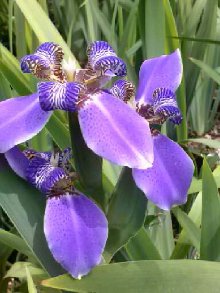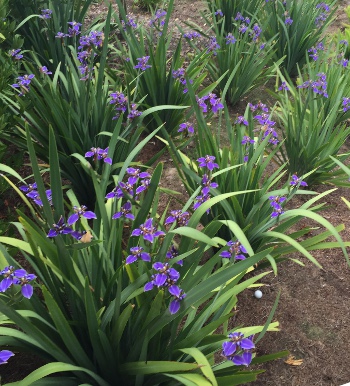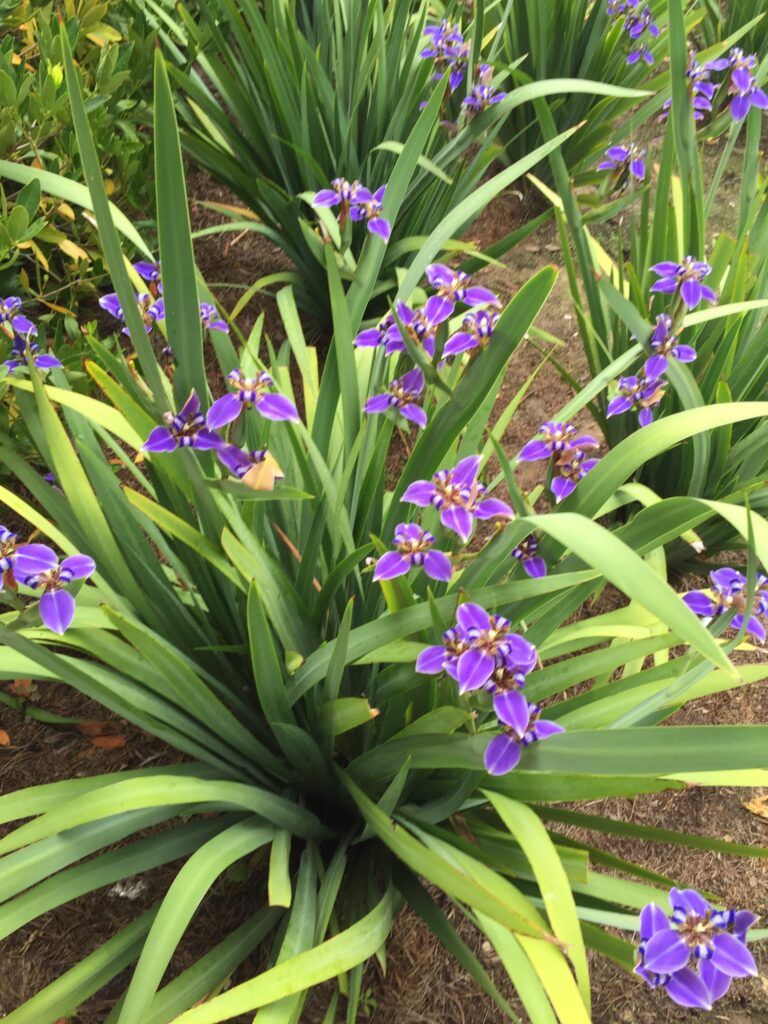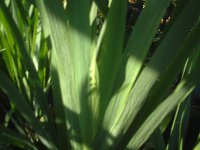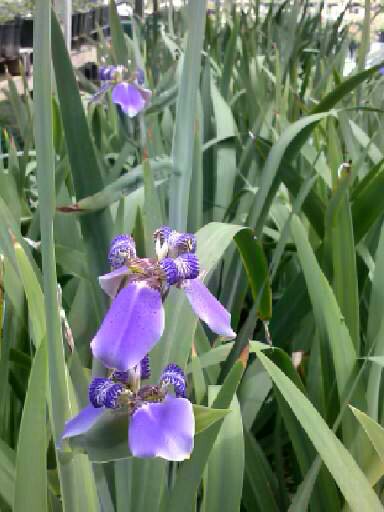S & J Nursery’s Guide to Growing
Giant Apostle Iris ‘Regina’ / Brazilian Iris
in our Northeast Florida Landscape
( Neomarica caerulea ‘Regina’)
Giant Apostle Iris ‘Regina’ / Brazilian Iris Noemarica caerulea ‘Regina’Origins:
When you see the strong upright form and big wide foliage
of these beautiful Giant Apostle Iris plants you will immediately wonder where you can find space for one in your garden! And at the first sight of one in bloom, you will immediately start tearing out other plants to make room for more of these! They really are just that pretty. Imagine my delight when I realized that it just sat there in my garden all year long without needing any help from me at all and bloomed even better the next year. It’s every gardeners dream!
I first ran into one of these plants at a garden center 4 or 5 years ago and
immediately grabbed one up, all the while thinking this thing is too good to be true, it has got to die during the winter / shrivel up and disappear during the rain season / get destroyed by bugs…surely there was a reason why after 15 or more years in this industry I had never laid eyes on this plant! After it lived through the first winter and bloomed the following spring, I started looking for more!
Unlike so many other members of the Iris family that grow so well in other
parts of the country but fail to thrive through our hot summer months, Walking Iris loves the heat. Native to Brazil, Neomarica can take all the rain and humidity our semitropical climate zone will give it.
– Although a walking Iris plant, the Regina’s strong upright habit very rarely allows the “walking” across the landscape that others so readily do but is by no means a less vigorous grower.
Preferred Exposure of the Giant Apostle Iris / Neomarica caerulea ‘Regina’ /
Brazilian Iris:
– Giant Apostle Iris can be planted in full sun to full shade in just about any type of garden you can think of. But I have found it to do best in morning sun with afternoon shade in my home garden, any filtered light situation under tall trees will find them thriving as well. The basic rule of thumb for these is make sure your planting into an irrigated area if you have a full sun site where you want them. They will need water twice a week during the hot summer months.
Foliage on the Giant Apostle Iris / Neomarica caerulea ‘Regina’ / Brazilian
Iris:
– Glossy green sword-like foliage stands erect in clumps and adds an instant
tropical feel to the garden or landscape.
– Although the plants themselves are hardy down to 20 degrees newly planted Apostle Iris or Apostle Iris planted into areas of the landscape that receive heavy frost during winter can suffer cold damage. Trim off any damaged plants to about 6-12 inches from ground level in early spring after all danger of frost has passed. Fertilize immediately after trimming and your Apostle Iris will regrow new foliage quickly.
Soil Preference / Salt tolerance of the Giant Walking Iris / Neomarica :
– Giant Apostle Iris is quite tolerant of a wide range of soil conditions from dry to consistently moist and is salt tolerant as well!
Giant Apostle Iris / Neomarica caerulea ‘Regina’ / Brazilian Iris: Size
Variance:
– 3-4 ft High and 2-3 ft wide..
Growth Habit of the Giant Apostle Iris / Neomarica caerulea ‘Regina’ / Brazilian
Iris::
– Boldly upright foliage is a soft grey green when new and a brilliant jade green when mature. Leaf blades are thicker and wider than other walking Iris plants.
– Plants should be dug and divided every 3- 5 years in early spring for best
flowering.
Growth Rate:
– Brazilian Iris ‘Regina’ is a fast growing perennial plant.
Bloom:
– Stunning 4 inch wide blue – purple blooms are rippled with interesting
zebra like stripes of white and maroon on the center petals. Blooms are held high on the plants just at the tops of the foliage.
Giant Apostle Iris / Neomarica caerulea ‘Regina’ / Brazilian Iris: Water
Requirements:
– Regina Iris plants although moderately drought tolerant once established in the landscape, they will require regular water to get the plant rooted and growing on it’s own after being planted in the ground from an S & J Nursery container. Use supplemental irrigation biweekly when planted in
a shady location that may receive full sun for a portion of the day rather than filtered light throughout the day that would be more hospitable or in well draining sandy soils for best flowering.
Best Uses For Apostle Iris Plants in the Northeast Florida | Jacksonville |
St. Augustine area Landscape:
– Apostle or Brazilian Iris plants are at home in any garden setting and blend in beautifully with surrounding perennial plants and shrubs etc.
– Giant Apostle Iris ‘Regina’ make excellent potted plants and their
strongly erect foliage adds a dramatic flare anywhere they are placed. I love to see them near patios, pools or walkways where the gorgeous blossoms can be appreciated up close.
– Although these plants stand alone beautifully they are also gorgeous
when planted in mass. Perfect in masses under larger trees or landscape specimen plant you want to draw attention to like a birdbath or statue. Massed plantings of Iris will instantly turn a drab tucked away corner
of the yard into a landscape showpiece.
– Great Pond side plant selection.
– Low maintenance landscape selection.
– Fire resistant
Care of Apostle Iris Plants:
– Water every day during the establishment period after planting in the garden from an S & J Tree Farm and Nursery container.
– When planted into a location that receives some direct sun or well drained sandy soils, supplemental irrigation is preferred for maximum flowering.
– As with all perennial plantings, amending the soil with compost when planting your Apostle Iris plants will help keep them healthy and happy through the years.
– Plants should be dug and divided every 3-5 years in the early spring.
– Fertilize each spring with a handful of garden compost or a mixture of Milorganite or Green Edge Fertilizer and a slow release poly coated plant food such as Osmocote or Stay Green general purpose plant food or 10-10-10.


